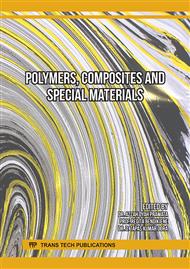[1]
Q. Zheng, M. M. Tavakoli, LAGu, D. Zhang, L. Tang, Y. Gao und Z. Fan, "Efficient metal halide perovskite light-emitting diodes with significantly improved light extraction on nanophotonic substrates.," Nature communications, p.10(1), 1-9., 2019.
DOI: 10.1038/s41467-019-08561-y
Google Scholar
[2]
M. Sathishkumar, M. Saroja und M. Venkatachalam, "Influence of (Cu, Al) doping concentration on the structural, optical and antimicrobial activity of ZnS thin films prepared by Sol-Gel dip coating techniques.," Optik, p.182, 774-785., 2019.
DOI: 10.1016/j.ijleo.2019.02.014
Google Scholar
[3]
T. And, L. Li, J. Xien. Chen, HAO. Shen, YIN. Wang und S. Chen, "Efficiency enchancement of organic light-emitting diodes via a self-assembled moth-eye nanopatterned hole-transporting layer.," Optics Express, p.29(5), 7210-7219., 2021.
DOI: 10.1364/oe.419850
Google Scholar
[4]
Y. J. Jung, S. Y. Cho, J. W. Jung, S. Y. Kim und J. H. Lee, "Influence of indium-tin-oxide and emitting-layer thicknesses on light outcoupling of perovskite light-emitting diodes.," Nano Convergence, p.6(1), 1-5., 2019.
DOI: 10.1186/s40580-019-0196-z
Google Scholar
[5]
L. M. Cox, A. M. Martinez, A. K. Blevins, N. Sowan, Y. Ding und C. N. Bowman, "Nanoimprint lithography: Emergent materials and methods of actuation.," Nano Today, p.31, 100838., 2020.
DOI: 10.1016/j.nantod.2019.100838
Google Scholar
[6]
A. Ngamaroonchote, C. Chotsuwan, K. Tantisantisom und R. Laocharoensuk, "Patterned gold electrode prepared from optical discs display largely enhanced electrochemical sensitivity as exemplified in a sensor for hydrogen peroxide.," Microchimica Acta, pp.211-218, 2017.
DOI: 10.1007/s00604-016-2008-z
Google Scholar
[7]
A. Al-Sharabi, NA. Alemanha, A. O. Ahmed und N. A. Yahya, Effect of Copper Doping on Structural and Optical Properties of Zinc Sulfide (ZnS) Nanoparticles., Al Baydha University Journal, p.1(2), 224-234., 2019.
DOI: 10.56807/buj.v1i2.25
Google Scholar
[8]
W. L. Yeh, C. M. Fang und Y. P. Chiou, "Enhancing LED light extraction by optimizing cavity and waveguide modes in grating structures.," Journal of Display Technology, p.9(5), 359-364., 2013.
DOI: 10.1109/jdt.2012.2229382
Google Scholar
[9]
H. Li, B. Dong, X. Zhang, X. Shu, X. Chen, R. Hai und C. Sun, "Disposable ultrasound-sensing chronic cranial window by soft nanoimprinting lithography.," Nature communications, p.10(1), 1-9., 2019.
DOI: 10.1038/s41467-019-12178-6
Google Scholar
[10]
V. Bhingardive, L. Menahem und M. Schvartzman, "Soft thermal nanoimprint lithography using a nanocomposite mold.," Nano Research, p.11(5), 2705-2714., 2018.
DOI: 10.1007/s12274-017-1900-0
Google Scholar
[11]
A. A. Othman, M. A. Osman, M. A. Ali und E. M. M. Ibrahim, "Influence of transition metals dopant type on the structural, optical, magnetic, and dielectric properties of ZnS nanoparticles prepared by ultrasonication process.," Materials Science and Engineering, pp. B, 270, 115195, 2021.
DOI: 10.1016/j.mseb.2021.115195
Google Scholar
[12]
B. Chen, C. J. Mathai, S. Mukherjee und S. Gangopadhyay, "Indium tin oxide photonic crystal for controllable light coupling in solar cells by an inexpensive soft lithography with HD-DVD and blu-ray.," ECS Transactions, p.61(18), 69., 2014.
DOI: 10.1149/06118.0069ecst
Google Scholar
[13]
B. Yu, Z. Huang, D. Fang, S. Yu, T. Fu, Y. Tang und Z. Li, "Biomimetic Porous Fluoropolymer Films with Brilliant Whiteness by Using Polymerization‐Induced Phase Separation.," Advanced Materials Interfaces, p.9(1), 2101485., 2022.
DOI: 10.1002/admi.202101485
Google Scholar
[14]
A. J. Islam, M. S. Islam, M. R. Islam, C. Stampfl und J. Park, "Thermal transport in monolayer zinc-sulfide: effects of length, temperature and vacancy defects.," Nanotechnology, p.32(43), 435703., 2021.
DOI: 10.1088/1361-6528/ac12ec
Google Scholar
[15]
L. Dai, R. Lesyuk, A. Karpulevich, A. Torche, G. Bester und C. Klinke, "From Wurtzite nanoplatelets to zinc blende nanorods: simultaneous control of shape and phase in Ultrathin ZnS nanocrystals.," The journal of physical chemistry letters, p.10(14), 3828 - 3825, 2019.
DOI: 10.1021/acs.jpclett.9b01466
Google Scholar
[16]
R. A. Babatunde, Y. I. Bolanle und O. O. Adegboyo, "Effects of deposition time of ZnS thin film on optical and morphological properties of ZnS deposited by chemical bath deposition method for photovoltaic application.," Journal of Theoretical & Applied Physics, p.1, 38-45., 2019.
Google Scholar



